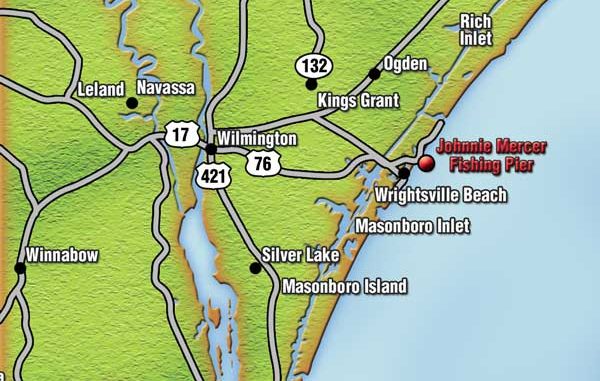
The family of fishermen at the end of Johnny Mercer’s Pier enjoy each other’s company and top king mackerel fishing each fall.
When the first nor’easter blows, the water begins cooling for the fall, giving anglers itchy riggin’ fingers.
An onshore wind at the New Hanover County coast, a northeaster, stacks menhaden and other baitfish against the beaches, luring big schools of predator fish toward the “hill” and near pier fishermen.
One of those predator species include broad-shouldered king mackerel. The subject of many fishing tournaments and light-tackle trips, kings are highly sought by anglers fishing from center console boats.
Outside of tournaments, king mackerel often are relegated to the ranks of “other” gamefish for most boating fishermen. But among dedicated anglers such as Bill Carr, who padlock themselves to the ends of ocean piers each fall, kings reign supreme.
“I’d rather fish for kings than anything else,” said Bill Carr, a construction worker for New Hanover County schools. “I caught the pier record king in 2004. It weighed 37 pounds, 12 ounces.”
Carr lives at Wrightsville Beach, so it’s only natural he fishes at Johnnie Mercer’s Pier. He was weighing a recent catch at the pier’s scales with the help of pier-owner Matt Johnson. Mercer’s is the only concrete pier at the N.C. coast.
“When we built the pier, we wanted it to withstand any hurricane,” Johnson said. “It has steel grates along the center so you can llook down beneath look beneath your feet and see the ocean. The grates allow high waves to rush up through them so they won’t lift or damage the pier.”
Johnson said the 2007 fall run of kings was one of the best experienced at the pier and lasted into November. He said pier regulars often landed their three-fish daily limits.
“We’re a family-oriented pier,” Johnson said. “The concrete pier is safe for kids, and the guys watch out for them. The pier house is a gathering place for everyone, and there are no strangers at the end of the pier.
“Gerald Cooney, a former outdoor writer for the Wilmington newspaper, nicknamed the guys who fish at the end the ‘End-of-the-Pier Gang.’His nickname for king mackerel fishermen has stuck for decades.”
Members of the End-of-the-Pier Gang such as Carr know how to catch king mackerel and some of their techniques are specific to fishing from a concrete pier. More concrete piers are planned for the coast, with one already on the drawing board for a state-owned pier on the Outer Banks. The plans were based on the plans for Johnnie Mercer’s Pier.
“I’ve been coming to visit the pier since my parents brought me for vacation in the 70s,” the 38-year-old Carr said. “I began fishing with Matt when we were kids, and I think it’s the best pier on the coast.”
Carr landed his most recent catch, which tipped the scales at 16.8-pounds, by using a pinfish for bait. He used a trolley rig to put the baitfish in the strike zone, 900 feet seaward from the scales where his fish his fish was hanging. The length of the pier is 945 feet from the beginning of the ramp to the end of the pier.
Out at the end were several other king mackerel fishermen, their rods set in pairs in various styles of rod holders. At wooden piers, anglers may simply use bungee cords to tie their rods to the rails. But the concrete pier railing is tough on fiberglass, butts and guides.
“I made a custom rod-holder from a couple of strips of wood, some pipe clamps and some PVC pipe,” said Michael Bonzer, a Wilmington heating-and-air-conditioning contractor. “It takes two rods for king fishing, an anchor rod and a fight rod.”
Bonzer used a 10-foot surf rod for an anchor rod, casting a heavy surf sinker with wire stabilizers. He used a second surf sinker with the wires removed as a weight for the trolley, which slid his bluefish bait along the anchor rod line to the water. A wooden clothespin served as the release clip holding the fighting-rod line. The 6-foot fighting rod had a revolving spool reel and was set nearly parallel to the water in a PVC swivel rod-holder on top of a section of PVC pipe (See diagram).
The leader consisted of three treble hooks tied in tandem with a 4-foot wire leader. The leader was single-strand, 45-pound test stainless steel and the hooks were No. 4 trebles.
Bonzer watched his bluefish swimming in circles, the lines bowing in the wind. Someone spotted a dark shape in the water.
“There’s a king in the baits,” Rick Britt said with a shout. “Watch your rods.”
Bonzer’s fight rod twitched as the king mackerel struck. The reel’s warning clicker screeched while the fish ran. Bonzer picked up the rod and held on as the king ran off a couple hundred yards of line, then he expertly worked the king back to the pier.
He reeled only when the king was not taking line, using fast turns on the reel handle as he lowered rod down to the water, then gently hauled back on the rod to pull the fish toward the pier.
After a couple of short runs, with Bonzer reeling and pumping the rod, the king was beside the pier. All the other anglers were beside their rods. Some of them moved their rods and lines out of the way as Bonzer played his fish. Then a rope gaff was lowered. As the king circled above it in an exhausted state, the gaff was lifted and the king hauled up to the pier’s decking.
“It’s my third fish of the day, so I’m done,” Bonzer said. “I’m headed back to work.”
Bonzer released the tension on a cargo strap holding his custom rod-holder to the rail. Matt Johnson accompanied his boyhood fishing pal, walking down the pier to the scales. But several more anglers remained at the end of the pier.
Rick Britt had caught one king and was baiting a rig with a pinfish for another try. Britt holds the red drum record at the pier and fishes for king mackerel four or five days per week.
“If I’m not fishing, I’m out here with the gang,” he said. “I live 10 minutes away, and I’m retired, so I fish four or five days a week.”
Britt caught 18 kings from the pier in 2007. He said like most anglers he preferred a bluefish for bait.
“I use a spinning rod with a Got-cha lure to catch bluefish,” he said. “But I also use pinfish, cigar minnows or shad. There’s no live bait tank at the pier, so I use a couple of 10-gallon buckets and three bait bags net to keep baits alive. I’m always catching bait while I watch my rods.”
Rod watching is a big part of the teamwork used for success by the End-of-the Pier Gang. Britt said if a reel goes off, he shouts for everyone to go to their rods.
“You don’t want to lift someone else’s rod unless you know them,” he said. “But you don’t want your rod to be in the way of someone else who’s playing a fish.”
Britt’s anchor rod is a 12-foot Tika with a Diawa SL30SH reel spooled with 25-pound test mono. He molds his own surf sinkers, 7-ounce torpedo weights with four wire prongs and a wire shaft. He clips a snap swivel around the anchor line for his trolley rig, with 4 inches of single-strand wire below the swivel holding a 4-ounce egg sinker and a clothespin. The clothespin has a rubber band wrapped around the tip to increase tension on the line. His favorite fight rod is a 7-foot Okuma Tailwalker with a Shimano Torium model 30 reel spooled with 30-pound mono.
“You need a reel that holds at least 300 yards of line,” he said. “My reel has 300 yards of 30-pound braided backing, which takes up little room. Another 300 yards of mono gives me over 600 yards on the reel.
“I use a double Uni-knot or PR knot to make tie the mono to the braided line. You never know when a tarpon might hit, and you could need extra line. I also use a Torium 50 when tarpon are around because it holds a lot more line and is a smooth reel. You need a smooth drag. You can’t have a jerky drag or it’ll pull the hooks.”
Britt ties a top shot of 20 yards of 100-pound braid directly to his king mackerel rig. The rig is seven-strand wire of 80-pound test, snelled to three treble hooks in series a few inches apart depending on the size of the baitfish. He puts the first hook in the back of the head of the bait, wraps the leader around the fish then inserts the second hook into the bait near the anal fin.
“If it’s a big bluefish bait, I bury all three hooks with the last hook inserted into the tail,” he said. “The idea is to have hooks everywhere. You might wait hours and day for a strike and when the fish gets his mouth around that bait, you want to make sure he gets a mouthful of hooks.”
The braid top shot protects the line from pier pilings. Britt said it’s a necessity for fishing from a concrete pier.
“When the pier was made of wood, if the line hit the pilings, it would hold most of the time,” he said. “But if a mono line hits a concrete piling, it cuts right off.
“When I hook the clothespin to the braided line top shot, I loop a rubber band around the end of the clothespin and also around the braid and cinch it down tight. I can fish it with lighter or heavier tension, depending on the seas and the size of the bait.”
Britt slides the release rig up or down the line to determine how deep the bait goes. He prefers running the dropper at 12 feet. But if there are lots of other lines in the water, he fishes the dropper as short as 4 feet.
“I only use 3-feet wire leader, and I’ve never had the 100-pound braid or the leader break on anything,” he said. “But another thing you have to worry about is barracuda. There are always some around because they like the concrete pier and won’t miss a chance to eat a hooked king.
“I want that king completely worn out when he comes over the gaff so I can land him fast enough to keep him away from a barracuda.”
Britt uses a custom 9-pound, 4-prong stainless steel gaff with a 2-foot stainless shaft. He said gaffs are as varied as the fishermen, with most of them custom made at machine shops.
“You’d better bring your own gaff because you can’t always depend on other anglers bringing theirs,” he said. “You might even wind up fishing by yourself and have to shout for help with the gaff.”
Britt said he lowers the gaff and keeps it as motionless as possible. But sometimes the wind makes it move, making gaffing difficult. He said the angler works the fish over the gaff and the gaffer simply lifts it up.
“If you move the gaff or it’s windy, it will swing out of control,” he said. “I add 3 feet of chain for weight and to protect it from sharks. I’ve had sharks bite through the rope.”
Britt said while the fish is being hauled to the pier deck, he loosens the drag. In the event the fish slips the gaff, it gives him another chance to land it.
“If the fish falls and the drag’s tight, the hooks will pull out,” he said. “I’ve seen fish bounce off the rail and fall. To prevent that from happening, you should grab the gaff shaft as it nears the rail, then swing the fish over.
“It’s a great feeling to catch a king and everybody’s happy for you. There are no strangers, way out here at the end of the pier.”


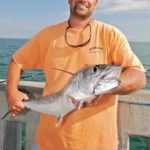
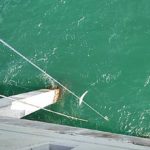
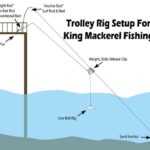
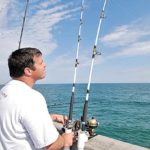
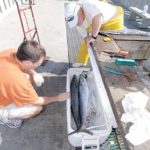
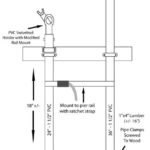
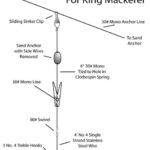
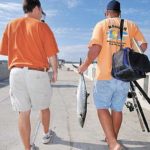
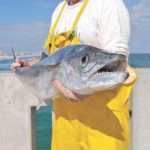




Be the first to comment